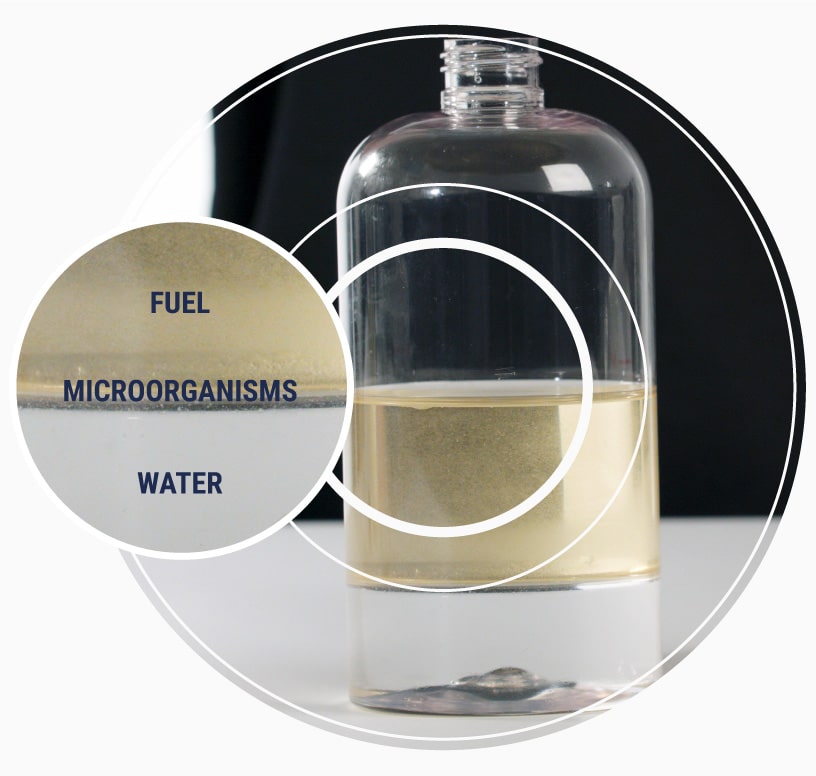What is jet fuel testing?
Managing microbiological contamination is an important issue in the aviation sectors. Organisations like The International Air Transport Association (IATA) and the Joint Inspection Group (JIG) provide extensive guidance around how to minimise dangerous contamination. They generally recommend regular testing of fuel, alongside water removal practices.
Many aviation organisations, along with the supply chain of jet fuel suppliers, follow this guidance and test their fuel regularly.

What is a jet fuel test kit?
The commercial and business aviation sector has vast experience in managing microbiological contamination in jet fuel. The International Air Transport Association (IATA) provides strong guidance on this subject, and more advice can be found in the maintenance manuals of most aircraft manufacturers. Jet fuel test kits are an integral part of managing microbiological contamination.
The supply chain of fuel suppliers will also monitor jet fuel for microbial contamination using jet fuel test kits. These suppliers, also known as into-plane fuel supply organisations, follow guidance from the Joint Inspection Group (JIG).
Read More >> Jet Fuel Contamination
FUELSTAT® 15-minute jet fuel test
Easy immunoassay antibody testing that finds all dangerous microbes in aviation fuel.
Why do microbes live in fuel?
They are found in every habitat on the planet, and some have adapted to live in extreme conditions.
Some microorganisms such as bacteria, fungi, yeasts, are robust enough to thrive in the harsh environment of jet fuel. They get in through air and water and can feed off the hydrocarbons in fuel. To grow, all they need is a water source from a small amount of condensation or suspended water in jet fuel.
These microbes love hotter and more humid conditions. Accordingly, fuel users in hotter places are at high risk of getting microbial contamination, and of these microorganisms growing very quickly.

How do these microbes affect fuel?
Left unchecked, microbes can form into biofilm or produce large volumes of biomass and cause a number of serious issues. They cause problems with fuel quantity indication systems, filter malfunctions, and in cases of extremely heavy contamination, corrosion of tanks.
Catching microbiological contamination at its earliest stage is the easiest, cheapest and smartest solution. Jet fuel testing is essential for catching contamination before it reaches dangerous levels. When done alongside frequent water draining, testing forms part of a solid anti-contamination strategy.
Who would use a jet fuel test kit?
Operators of commercial aviation fleets, business jets, and private jets. These organisations are well versed in the potential risks of unchecked contamination from microbiological species in jet fuel. They will regularly use a jet fuel testing kits to understand if they have a microbial contamination issue, and at what level the contamination has developed.
MRO and FBO repair partners. They use jet fuel test kits to test fuel being taken from an aircraft in a maintenance/safety process called defueling. This helps them to establish that the fuel is free from microbiological contamination before it is stored with general fuel stocks. They also carry out jet fuel tests when undertaking regular maintenance.
The aviation jet fuel supply chain. Jet fuel tests are used for quality control, both by airlines auditing the operations of suppliers and by into-plane suppliers. These organisations seek to prove that measures and controls of quality are in place along the supply chain prior to uploading fuel onto an aircraft.
Read More >> Aviation Fuel Testing // Aircraft Fuel Testing
How do the different jet fuel tests work?
Some methods are also capable of identifying the specific groups of microbes present.
The idea is to directly or indirectly help you understand the severity of the contamination, if present, and how to deal with it.
There are three main types of test recommended by IATA and JIG for jet fuel testing.
CFU uses the oldest technology of any established fuel testing method. It is often conducted in an off-site laboratory but can also be done on-site using a thixotropic gel. The fuel sample is put in a medium and then grown in an incubator for generally 4-10 days. This method finds all culturable microbes found in the sample.
Testers have to follow guidelines to categorise the test results into industry-standard categories:
- Green: Negligible Contamination
- Amber/Yellow: Moderate Contamination
- Red: Heavy Contamination
A relatively complex method, ATP measures light emitted as a result of an ATP-mediated enzymatic reaction. It then produces a number indicating the amount of living microbial cells in the sample. ATP requires a piece of laboratory equipment called a luminometer and gives a result in minutes. However, ATP testing is often carried out at a different location to where the fuel samples were taken. Wait time for results can be affected by transport times, along with how the testers prioritise the sample in question.
Testers generally analyse the numbers produced, and then record results in the Green/Amber/Red categories, as above.
Immunoassay is the most modern fuel testing technology. Because it’s fast and can be done in situ, it’s suitable for on-site testing where minimal training is required. There is little risk of the test being done incorrectly.
Simply place 4 drops of sample onto the test kit and wait 10-15 minutes for the result. Immunoassay antibody tests give results in the industry-standard green/amber/red categories. It comes with a free app that verifies the result and shows it on-screen, records the data, produces unique pdf reports on each test instantly, and allows downloading of all test results.
Are there any risks or downsides with jet fuel tests?
Depending on the testing method used, there is a risk that misleading results can occur. This can potentially be very costly for a fuel owner. If the results show high levels of contamination where the contamination severity is not in reality alarming, the owner may pay for expensive fuel treatments that aren’t required—or even take their assets out of operation unnecessarily.
Misleading results typically occur for one of two reasons:
01.
Environmental changes that occur during handling and transport.
In warm environments, they can multiply quickly potentially giving misleading results on a test. This can lead to the test results showing certain levels of contamination when the actual fuel in the tanks has a safe level of microbes.
In colder environments, the microbes can go dormant or even finish their life cycle. This could lead to the tests showing a safe level of microbial contamination, where the actual fuel in the tanks has a dangerous level.
02.
Detecting microbes that may not be relevant to microbial fuel contamination but are present in the sample.
ATP and CFU tests will measure the amount of culturable microbes present, including ones that are not necessarily dangerous to fuel at that point. They then produce test results stating directly or indirectly, in the case of ATP, the amount ATP concentration present—but not the type. This can lead to misleading results, i.e. a ‘false alarm’ of contamination where large numbers of harmless at that time microbes are detected.
It’s worth noting that only immunoassay antibody tests look for specific microbes while ignoring ones that aren’t harmful to fuel.
FUELSTAT® 15-minute jet fuel test
Easy immunoassay antibody testing that finds all dangerous microbes in aviation fuel.
Can you carry out a jet fuel test yourself?
Some larger organisations need to carry out tests for things other than microbiological contamination and may find it more efficient and cost-effective to have their own testing facilities.
Smaller companies will most likely not have their own facilities and the costs of setting up, running and staffing a laboratory are not justified. However, there are jet fuel tests that you can do yourself if you don’t have your own laboratory.
Should you use an on-site or off-site jet fuel test kit?
When deciding between on-site and off-site tests of aviation fuel, the most important consideration is time. Tests for microbial contamination are very time-sensitive, whereas other tests, e.g. fuel specification tests are less so.
ASTM D6469 – 14, Standard Guide for Microbial Contamination in Fuels and Fuel Systems section 8.5 states:
“8.5 – Samples for Microbiological testing should be kept on ice for transport to the laboratory. Tests should be performed within 4h and no later than 24h after sampling. Samples stored at higher temperatures, or for longer times, can show the presence of microbial contamination that does not represent actual fuel system conditions.”
Microbial tests for aviation fuel are often carried out outside of routine maintenance, so are down when the aircraft is not in its hangar. At these times, testing is conducted at remote stations away from the organisation’s central hub.
Even when samples are sent to a laboratory owned by the organisation itself, it may be difficult to get them tested within the timeframe. It’s also very expensive to transport the fuel samples in compliance with the ASTM guidelines, so completing the task on-site is often more cost-effective.
Which jet fuel testing methods can be conducted on-site?
There are two jet fuel tests listed by IATA that could be classed as on-site. You would be able to conduct them under the wing or beside a defueling tanker, for example:
- Thixotropic Gel Method. This is a CFU growth test that can be done on-site. A sample is taken and put into a bottle, which is then incubated for 4-10 days at a set temperature. Although, in principle, the test can be done on-site, hangars or workshops don’t often have incubators. Without this equipment the organisation requiring the test needs to run the incubation phase off-site.
- Immunoassay antibody jet fuel tests. A few drops of fuel sample are placed onto a surface called a ‘testing well’. After a few minutes, the test gives a visual indication of the levels and type of microbes present. This testing of aviation fuel can be done on-site, without any special equipment, and without sterile laboratory conditions.
What jet fuel testing equipment would I need to make use of these methods?
- CFU testing requires basic laboratory equipment, growth material, and an incubator. If you are using the thixotropic gel method, the gel would be come in a test bottle from the manufacturer but, as always, an incubator is required for this method as well.
- ATP testing requires basic laboratory equipment and a luminometer.
- Immunoassay antibody testing requires no laboratory equipment, simply a clean jar and the testing materials supplied with the test itself.
GET IN TOUCH
FUELSTAT®: on-site immunoassay antibody testing that takes just 15 minutes
FUELSTAT is used by over 400 airlines, and independently verified to meet International Standard ASTM D8070.
See FUELSTAT® test kits
This is custom heading element